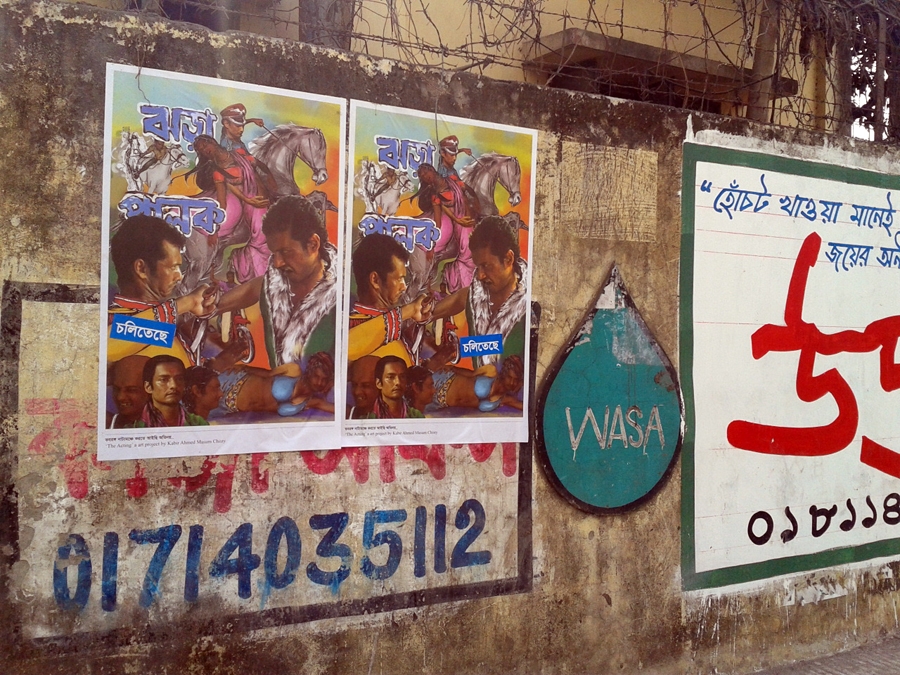In the car from Dhaka’s Hazrat Shahjalal Airport to my hotel I get a text from a friend, a British curator whose family comes from Bangladesh. It was in reply to a text I’d sent him, which mentioned I was off to the Dhaka Art Summit. His reply was a short, wry, rhetorical question: ‘Is the artworld in Bangladesh now? – is nothing sacred!?’
Bangladesh is a country that has not previously registered on the international artworld’s radar to any great extent, bar a few breakthrough artists such as Runa Islam (Bangladesh-born but London-based) and Naeem Mohaiemen (New York and Dhaka-based). While it is undoubtedly a culturally rich country (just a glimpse at the modernist architecture of Louis Kahn’s National Assembly Building, completed in 1982, and the universal popularity of the monthlong Ekushey Book Fair, confirms the country’s artistically progressive tendencies), contemporary visual art has made little local impact. Besides the notable exception of the pioneering Drik, which doubles as a photography agency, and artist-run nonprofit Britto Space, there are few local galleries and only a couple of desperately underfunded national institutions, much-maligned. This is surely down to economic reasons – whatever the argument towards the socially improving qualities of art, its public funding must be a low priority in a country where the capital’s pavements are frequently nonexistent, child begging is rife and 40 percent of the population lives in slums without sanitation. While the country is making inroads in reducing its poverty levels, it remains in the bottom quarter of the Human Development Index ranking, a composite statistic of life expectancy, education and income indices used by the United Nations Development Programme.
It is against this backdrop that the second Dhaka Art Summit opened. Funded and instigated by Nadia and Rajeeb Samdani, collectors whose business interests range from property to food (and who own a mix of art-fair-friendly works by Westerners such as Marc Quinn and Damien Hirst, and a more nuanced collection of art by South Asian artists), the summit is a multifaceted event. While the ground floor of the government-owned summit venue, the Shilpakala Academy building in central Dhaka, hosted large-scale commissions – Pakistan-born Rashid Rana’s full-scale replica of a gallery at Britain’s Tate Modern, albeit with the artworks and interpretation texts pixellated out; and Indian Shilpa Gupta’s bitty installation, investigating the chitmahals, the enclaves along the Bangladesh-India border, were highlights – the rest of the four-storey building was occupied by a performance and film programme, a series of independently curated shows, an art fair (predominantly featuring galleries from South Asia and the Middle East), an exhibition of work shortlisted for an emerging-artist prize (which, while varying in quality, gave a flavour of the mainly political concerns of local younger artists: a highlight, though not the eventual winner, was Kabir Ahmed Masum Chisty’s gif-like animation of a Bangladeshi action film poster; inanimate, paper versions of which were then flyposted across the city) and a busy timetable of panel discussions.
It was while on one of these panels that Mohaiemen, whose practice mixes object-making with critical research into the history of leftist politics, spoke about a research project he did for a Bangladeshi magazine, describing how he made it in the frustrating knowledge that it would never circulate beyond the publication’s Bengali-speaking readership. Mohaiemen was using the anecdote to question how art circulates. If a foetal local art scene wants to grow, and wants to be international-looking, it has to, for better or worse, speak the language of the international artworld. While we might have a democratic vision of art circulating freely via the web, artworks travelling across borders and critics reporting on farflung destinations, what the artworld resembles more closely is one of those maps airlines produce to show which routes they fly, where a spidery mass of lines radiates out from a few hubs. For anything to register to any notable extent – be it an article, work of art, curatorial endeavour – it must first pass through one of those hubs.
Formally the summit was a number of things combined: a distillation into one event of all the elements that normally come together to form a multifaceted, mature art scene. The aim of this was to communicate to the outside world, over the course of three days, a message of what Bangladesh could be for the artworld. An ecosystem that mixed the institutional, commercial and artist-run, in which it would be practical for artists to maintain international careers while being based in Dhaka and to translate local concerns to a global audience. In fact, the image of Dhaka not just being on the map, but being an international gateway. An ambitious vision given the country’s wider problems; but with its gradual economic advances and the few striving, well-placed personalities pushing it forward, it might not be entirely fanciful.
This article was originally published in the April 2014 issue.
